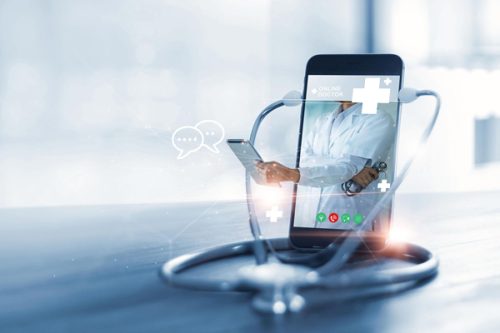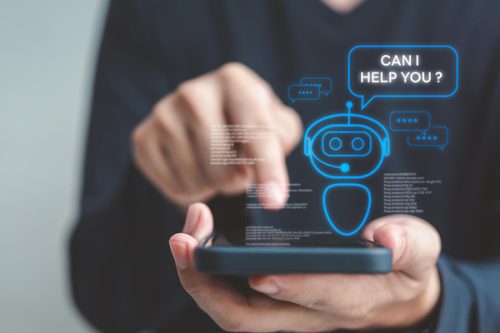Artificial intelligence (AI) is a vast field that is developing fast. Its possible applications can be confusing and intimidating for patients. At the same time, we face challenges and needs in healthcare where AI can provide support and offers solutions. Emily Lewis, a digital health innovator, knows both the industry’s and the patient’s perspective and will shed light on different aspects of the topic. She is confident that we can use technology to re-humanize healthcare and bring connection.
In the fourth part of our series about “AI in Healthcare”, Emily illustrates how AI can compensate for a lack of health personnel and how AI can be used to overcome challenges and inequalities related to healthcare access.
AI has great potential in reshaping healthcare, especially in regions that are underserved or face specific challenges. Here are some ways in which AI can compensate for the lack of health personnel, address healthcare access challenges, and drive society towards better health equity.
Care Delivery
Disease Prediction and Prevention
AI algorithms can analyze electronic health records and lifestyle data to predict the likelihood of various diseases, enabling early intervention. In Radiology and Imaging, for instance, AI can assist in analyzing medical images, which can be particularly useful in areas where expert radiologists are scarce. This ensures timely diagnosis even in remote regions.
- Butterfly Network: Butterfly Network has developed an AI-powered ultrasound device which can be used in resource-limited settings, such as in pregnant women in Africa, to track and monitor fetal development with biometrics.
- Caption Health: Caption Health has the first AI-guided heart ultrasound technology which enables a broad set of healthcare providers to perform high-quality ultrasound exams wherever and whenever patients need them through their Caption Care service within patients’ homes.
Customized Treatment Plans
AI can assist in personalizing treatment based on the individual’s genetic makeup, environment, and lifestyle, ensuring better outcomes.
- Vivante Health: Vivante Health personalizes care delivery for digestive conditions by including appropriate clinical interventions, utilizing cognitive behavioral therapy, diet and lifestyle recommendations, health articles and education, weekly live webinars, and a care team to help patients to focus on building healthier habits that are going to be the most meaningful in reducing their symptoms.

Remote Patient Monitoring and Virtual Care Delivery
AI can be used to create virtual care platforms that allow patients to connect with providers from anywhere in the world. This can help to increase access to care for people who live in rural areas or who have difficulty traveling to see a provider. AI-powered virtual assistants can offer basic medical consultations, especially for common conditions, reducing the need for in-person visits. What’s more, AI models trained in local languages can assist in breaking down language barriers in healthcare delivery, easily translating from one language to another in real time in a culturally competent way. Wearable and Internet of Things (IoT) devices that utilize algorithms to track health metrics can alert individuals and healthcare professionals about potential health issues.
- WellDoc: WellDoc is transforming healthcare with a chronic care platform that integrates personalized, real-time, and actionable insights into the daily lives of individuals, enabling improved health outcomes. Their AI-engine connects siloed data sources to deliver connected care across multiple conditions and comorbidities.
- Eko: Eko is applying machine learning in the fight against heart and lung disease with AI-powered smart stethoscopes.
- Soundable Health: Soundable Health is a digital health startup with AI-enabled tech, capturing audible biomarkers through smartphones to bring medical insights closer to empower stakeholders in health management. Their first product ProudP analyzes the sounds of urination and is currently in clinical trials.
Facilitating Quality Care
AI can also help to create more supportive and compassionate care environments. AI-powered chatbots can provide 24/7 support to patients, answering questions and providing emotional support. AI can also support continuity of care by assisting in transitions between different care settings (e.g., from hospital to home) and facilitating communication among different healthcare providers. AI can streamline guided clinical workflows and help reduce medical errors by flagging potential risks and inconsistencies, such as harmful drug interactions, that a busy healthcare provider might miss. This allows for safer, more accurate provision of care.
- Alio: Alio provides medical-grade, actionable data to dialysis patients’ clinical care teams in real-time, from wherever the patient may be. Their platform monitors through a single, non-invasive, wearable device (Alio SmartPatch). The clinical care team receives notifications through a portal (web or electronic health record (EHR)) if patient metrics are abnormal (as defined by specific guidelines) and require follow-up.
Enhanced HCP Training
AI can be used to create virtual training programs for healthcare workers, enhancing their skills even if they are in remote locations. Generative AI can be especially helpful in teaching differential diagnosis and coming up with fictitious scenarios in which trainees need to navigate.

Public Health
Targeting of Higher Risk Areas
AI can analyze data to determine which areas or populations are at higher risk for specific health issues, enabling targeted public health campaigns.
Optimizing Resource Allocation
AI can predict patient influx, helping hospitals and clinics in underserved areas better allocate their resources (supply chain of medicines and medical supplies) and staff. Mobile apps powered by AI can collect health data from patients in remote areas, allowing for better epidemiological tracking and intervention.
- Infermedica: Infermedica is automating primary care from symptom to outcome through their Medical Guidance Platform. Their flexible application programming interface (API) helps healthcare providers, telehealth systems, national healthcare systems, and healthcare practices to accurately analyze symptoms and steer patients to the appropriate level of care-reducing costs, increasing efficiency, improving the patient experience, and reducing unnecessary emergency department visits.
Effectiveness and Equity of AI-Powered Tools
To ensure that AI-powered tools are effective and equitable, developers in AI need to adhere to the following principles:
Industry Collaboration
Foster within-industry collaboration to establish frameworks and share best practices and resources for ethical AI development.
- Examples: Coalition for Healthcare AI (CHAI) and the Alliance for Artificial Intelligence in Healthcare (AAIH)
Data Collection
Ensure diverse training datasets to help create algorithms that are effective across various populations.
Bias Detection
Design AI tools to detect and correct biases in medical data or previous clinical decision-making processes.
Transparency, Explainability, and Accountability
Ensure that tools can explain AI decision-making and recommendations in a way that medical professionals understand and that avoids perpetuating biases.
Collaborative In-Community Development
Involve the specific communities which will use the product. Understand their needs in the development phase and ensure that the tool is tailored (e.g. “fine-tuned”) to these needs and is sensitive to local dynamics.
Conclusion
The potential benefits of healthcare AI in addressing access and health disparities are vast. However, developers in AI need to realize that these benefits require a keen emphasis on human-centered design, thoughtful implementation, and continuous monitoring and oversight.





vinod gupta 19.06.2024 at 13:23
Many patients undergoing robotic surgeries have reported faster healing, less pain, and shorter hospital stays, which underscores the effectiveness of these artificial intelligence in healthcare examples in improving outcomes.